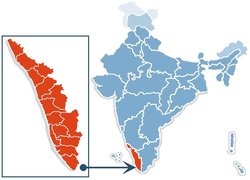Kerala

Kerala, India
Kerala, a state located at the tip of India’s southwest coast, has captured the attention of environmental and developmental scholars who address the question: can impoverished societies improve their lot without industrialization so as to bypass its high hurdles and adverse environmental impacts? The “Kerala model”, perhaps unique, suggests that great improvements in quality of life can be achieved through the reform of social, political and economic institutions without pursuing programs aimed at economic growth.
Kerala is a poor, densely-populated and principally agrarian state of some 30 million inhabitants. It is unusually cosmopolitan, perhaps the result of centuries of maritime trade. The independence of India from Great Britain in 1947 allowed the Keralites to build upon their tradition of public action to radically alter the fabric of their daily life. In 1956, the newly-formed state of Kerala elected as its first government a communist regime devoted to the social security and increased personal freedom of all. This entailed a reduction of the material and sociopolitical oppression of its underprivileged citizens, whether male, female, urban, rural, low caste or tribal. Within a generation’s time, and despite its poverty and the repudiation of this reform program by the central Indian government, Kerala surpassed most or all of the other Indian states in many important indices of human welfare. The beneficial changes, especially for women, greatly improved longevity, literacy and infant survival. By the late 1970s, Kerala led India in such public services as roads, post offices, primary and secondary schools, easily-accessed medical facilities, banks and more. Through far-reaching land reform, agricultural fields were turned over from landlords to tenants. The well-entrenched caste system was overturned. Public food programs put a floor under the nutrition of mothers and children, utilizing such mechanisms as ration cards and free school lunches. The birth rate in Kerala was brought below that of the rest of India, to rival that in more advanced nations. In this way, the basic needs of the people for civil and human rights, social security and fair opportunity were ameliorated within the span of a few decades. Nevertheless, unemployment and poverty have remained high; the per capita gross domestic product (GDP) in Kerala is still in the range of three dollars a day, typical of poor nations generally and below the average in India.
Kerala’s reforms were based on a powerful system of social values and institutions and a decentralized, community-based, bottom:up, non-governmental organization (NGO)-driven approach to the welfare of the needy. But how were the many social benefits paid for, given Kerala’s persistent poverty? Of course, the redistribution of existing wealth and assets was integral to this program. In addition, Kerala’s reforms bolstered its human capital and social capital, creating a more productive work force. Another asset in play were the cash remittances sent home to Kerala by family members working abroad, most notably in the oil industry of the Middle East. Finally, as is the case in developing nations, Kerala has benefited greatly from the spill-over of progress made by industrial nations; that is, access to knowledge and technology from the modern world. The acquisition of inexpensive know-how has allowed Kerala to build its health, education and social support systems.
Kerala’s example suggests that welfare can be dramatically advanced in poor nations by institutional change that is low in cost and non-industrial in nature through societal improvements that are not predicated on economic growth. Nevertheless, developing nations have not generally followed Kerala’s lead. Perhaps this is because poverty and unemployment persist in Kerala. Also, the historical basis for Kerala’s success may be considered too unique to be replicable. In particular, developing nations and other Indian states may lack Kerala’s institutional ideals, adhering instead either to traditional or industrial value systems or simply to the status quo. It is also true that reallocation of assets to the poor can reduce capital investment and work against economic growth in the short term. (On the other hand, when redistribution promotes the formation of human capital and social capital—in the form of a healthier, better fed and more skilled citizenry—it can soon increase general wealth and welfare. Indeed, the growth of Kerala’s gross domestic product (GDP) has been robust in recent years.
Finally, Kerala’s future trajectory is uncertain. Is it headed toward unsustainable industrialization in the pursuit of economic growth? Or, as Gandhi would have liked, can it pursue its experiment in social and human development that minimizes environmental impact?
Further Reading
- Franke, R.W. and Chasin, B.H. 1989. Kerala: Radical Reform as Development in an Indian State. The Institute for Food and Development Policy, San Francisco, CA, 122 pp. ISBN: 0935028587.
- McKibben, B., 1996. The enigma of Kerala. Utne Reader, March–April, 103–112.
- Parayil, G. 2000. Kerala: The Development Experience: Reflections on Sustainability and Replicability. Zed Books, New York, NY, 274 pp. ISBN: 1856497275
- Ramachandran, V.K., 1996. On Kerala’s development achievements. In J. Drèze and A. Sen (Editors), Indian Development: Selected Regional Perspectives. Oxford University Press, New Delhi, 205-356. ISBN: 019829204X